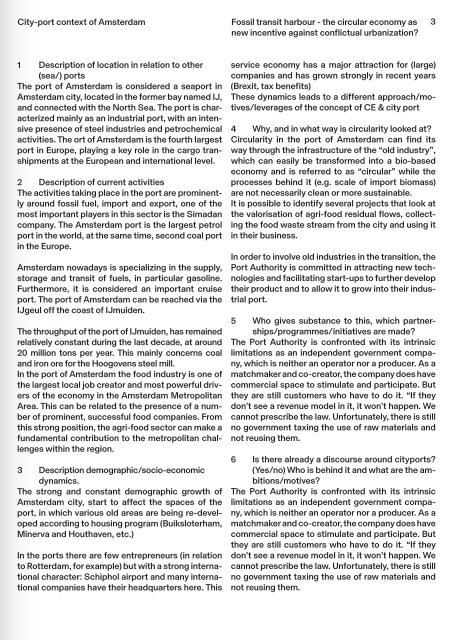Circular City Ports - Workbook
You also want an ePaper? Increase the reach of your titles
YUMPU automatically turns print PDFs into web optimized ePapers that Google loves.
<strong>City</strong>-port context of Amsterdam<br />
Fossil transit harbour - the circular economy as<br />
new incentive against conflictual urbanization?<br />
3<br />
1 Description of location in relation to other<br />
(sea/) ports<br />
The port of Amsterdam is considered a seaport in<br />
Amsterdam city, located in the former bay named IJ,<br />
and connected with the North Sea. The port is characterized<br />
mainly as an industrial port, with an intensive<br />
presence of steel industries and petrochemical<br />
activities. The ort of Amsterdam is the fourth largest<br />
port in Europe, playing a key role in the cargo transhipments<br />
at the European and international level.<br />
2 Description of current activities<br />
The activities taking place in the port are prominently<br />
around fossil fuel, import and export, one of the<br />
most important players in this sector is the Simadan<br />
company. The Amsterdam port is the largest petrol<br />
port in the world, at the same time, second coal port<br />
in the Europe.<br />
Amsterdam nowadays is specializing in the supply,<br />
storage and transit of fuels, in particular gasoline.<br />
Furthermore, it is considered an important cruise<br />
port. The port of Amsterdam can be reached via the<br />
IJgeul off the coast of IJmuiden.<br />
The throughput of the port of IJmuiden, has remained<br />
relatively constant during the last decade, at around<br />
20 million tons per year. This mainly concerns coal<br />
and iron ore for the Hoogovens steel mill.<br />
In the port of Amsterdam the food industry is one of<br />
the largest local job creator and most powerful drivers<br />
of the economy in the Amsterdam Metropolitan<br />
Area. This can be related to the presence of a number<br />
of prominent, successful food companies. From<br />
this strong position, the agri-food sector can make a<br />
fundamental contribution to the metropolitan challenges<br />
within the region.<br />
3 Description demographic/socio-economic<br />
dynamics.<br />
The strong and constant demographic growth of<br />
Amsterdam city, start to affect the spaces of the<br />
port, in which various old areas are being re-developed<br />
according to housing program (Buiksloterham,<br />
Minerva and Houthaven, etc.)<br />
In the ports there are few entrepreneurs (in relation<br />
to Rotterdam, for example) but with a strong international<br />
character: Schiphol airport and many international<br />
companies have their headquarters here. This<br />
service economy has a major attraction for (large)<br />
companies and has grown strongly in recent years<br />
(Brexit, tax benefits)<br />
These dynamics leads to a different approach/motives/leverages<br />
of the concept of CE & city port<br />
4 Why, and in what way is circularity looked at?<br />
<strong>Circular</strong>ity in the port of Amsterdam can find its<br />
way through the infrastructure of the “old industry”,<br />
which can easily be transformed into a bio-based<br />
economy and is referred to as “circular” while the<br />
processes behind it (e.g. scale of import biomass)<br />
are not necessarily clean or more sustainable.<br />
It is possible to identify several projects that look at<br />
the valorisation of agri-food residual flows, collecting<br />
the food waste stream from the city and using it<br />
in their business.<br />
In order to involve old industries in the transition, the<br />
Port Authority is committed in attracting new technologies<br />
and facilitating start-ups to further develop<br />
their product and to allow it to grow into their industrial<br />
port.<br />
5 Who gives substance to this, which partnerships/programmes/initiatives<br />
are made?<br />
The Port Authority is confronted with its intrinsic<br />
limitations as an independent government company,<br />
which is neither an operator nor a producer. As a<br />
matchmaker and co-creator, the company does have<br />
commercial space to stimulate and participate. But<br />
they are still customers who have to do it. “If they<br />
don’t see a revenue model in it, it won’t happen. We<br />
cannot prescribe the law. Unfortunately, there is still<br />
no government taxing the use of raw materials and<br />
not reusing them.<br />
6 Is there already a discourse around cityports?<br />
(Yes/no) Who is behind it and what are the ambitions/motives?<br />
The Port Authority is confronted with its intrinsic<br />
limitations as an independent government company,<br />
which is neither an operator nor a producer. As a<br />
matchmaker and co-creator, the company does have<br />
commercial space to stimulate and participate. But<br />
they are still customers who have to do it. “If they<br />
don’t see a revenue model in it, it won’t happen. We<br />
cannot prescribe the law. Unfortunately, there is still<br />
no government taxing the use of raw materials and<br />
not reusing them.


















